

Famous Cases | Historical Tales | Vampires | Zombies
 |  |
Famous Cases | Historical Tales | Vampires | Zombies |
 |
| The FVZA Book of Valor |
Answer: I wish I could say that FVZA agents killed in the line of duty received a burial with full military honors. In reality, however, there was no such fanfare. Since the modern U.S. government never officially acknowledged the agency's existence, agents were buried in their hometowns without any honor guard. Widows of deceased agents did receive an American flag. Official obituaries typically described the deceased as having been agents of the FBI.
I often note that FVZA agents had to be a special breed, because not only did they risk death on a daily basis to keep their fellow citizens safe; they had to do it in complete and absolute anonymity. There were no parades, medal ceremonies or remembrances.
This oversight struck me deeply during a recent Veteran's Day celebration at my grandson's school. One by one, veterans from World War II, Korea, Vietnam and Iraq were called onstage, where they accepted heartfelt applause and a commemorative ribbon. While I was happy to see our veterans get the acknowledgment they deserve, I couldn't help but feel pangs of sadness over the absence of FVZA agents in the ceremony.
I hope this doesn't sound like sour grapes, or the grumblings of a undernourished ego. It's just that I know firsthand the work that went into becoming an agent, and the courage it took to break down a door, never knowing the extent of the terrors waiting on the other side.
The U.S. government hasn't always neglected to honor the FVZA and its agents. At one time there was a Book of Valor on display in the U.S. Capitol that listed the names of FVZA agents who had lost their lives in the line of duty each year. Sometime in the late 1960s, as plans to close the FVZA gathered steam, the book was put in storage. It's currently under lock and key somewhere in the bowels of the National Archives, gathering dust, like the very memories of the agency itself.
A: More than I care to remember, Rohan.
At various times throughout its history, the FVZA was called upon to investigate, in no particular order, demons; goblins; ghouls; aliens; Bigfoot; chupacabras; trolls; dragons; voodoo zombies; the Golem; and scores of other real or imagined menaces.
The FVZA handled these cases by default: there simply was no other U.S. agency capable of investigating paranormal and extraterrestrial phenomena.
I didn't care for this role, as many of these investigations proved fruitless and they took time away from the vital work of tracking and fighting vampires and zombies. But I can't say it was a complete waste of time. I retain some special memories from those days.
I remember sipping moonshine with a family of mountain folk in the West Virginia forest while waiting for the Mothman to appear. And then there was the night I spent hiding in the reeds along the shores of the Rio Grande with a local deputy sheriff, listening for the cries of La Llorona (the wailing woman). I lived among the Iroquois in upstate New York for an entire week while we tracked the fearsome Wendigo (it turned out to be a werewolf).
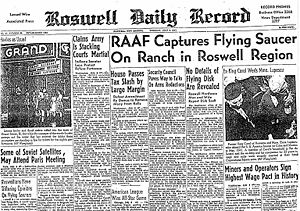 |
| 1947 headline on the Roswell UFO incident |
In the summer of 1947, an alien spacecraft crash-landed outside the small town of Roswell in southwestern New Mexico. Air Force officials recovered the remains of two alien life forms in the wreckage and transported them to Mountainair, New Mexico, home of the FVZA's Zozobra Project.
I was a young scientist then, working with the team that would one day discover the vampire vaccine. The aliens were put on ice in a heavily guarded outbuilding at the facility. Government officials wanted us to study the bodies and perform dissections.
I myself viewed the remains. They were six-foot-long, insectoid creatures with an exoskeleton and two large eyes on the ends of long stems. The buglike remains were a far cry from the big-headed, glassy-eyed aliens of popular culture.
I was anxjous to study the creatures' internal structures, but a day before the scheduled dissection, a cordon of trucks arrived at the facility and whisked the aliens away. We were told that the move was to protect us from exposure to any unknown viruses and bacteria, although many of us suspected an ulterior motive.
You see, McCarthyism was at its height in the United States at this time. In fact, many Zozobra Project scientists were suspected of being Communist spies. Most likely, the military higher-ups feared that any secrets about the aliens might fall into the hands of the Soviet Union. That was one theory, anyway. I didn't ask a lot of questions. My focus was on finding a vaccine to cure vampirism.
I never saw those remains again. Rumors persist that military eventually took the remains to Area 51 facility in Nevada, where they remain to this day.
Perhaps if the FVZA is reborn, we will have a branch dealing with extraterrestrials and cryptozoology. In the meantime, I plan to publish a database on the site with details on some of these creatures for informational purposes.
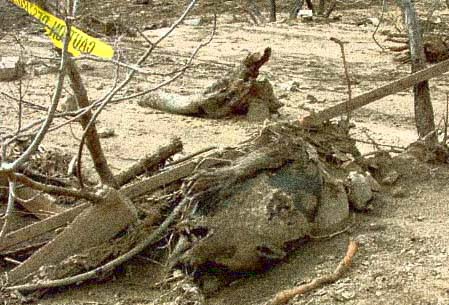 |
| Remains of werewolf killed in a mudslide in southern California, 1986 |
A: Werewolf attacks on humans are extremely rare, and evidence suggests that they are a matter of territory rather than hunger.
Werewolves are omnivores that will consume everything from berries to large ungulates such as elk and moose. Like other large predators, they don't appear to have a taste for humans.
That is not to say that werewolves never hunt humans. The Beast of Gevaudan killed more than 80 people in 1760s France, and a series of werewolf attacks on fishing camps and small towns in Wisconsin during the 1920s resulted in 23 deaths. That wolf was killed by a team of FVZA agents, and the subsequent autopsy revealed a viral infection in the wolf's brain, suggesting that it may have been suffering from derangement. Werewolf attacks on humans also are associated with droughts and other situations that might put the beasts under stress. But this is not a common phenomenon, as werewolves are much more adaptive than common animals.
Werewolves are highly territorial and easily threatened. A hiker blundering into their range might be shadowed for awhile and then left alone. A hunter or hunting party is far more likely to incite their wrath. If you wish to avoid becoming werewolf prey, do not travel in deep woods during the sunrise and sunset hours. Firearms likely will agitate the wolf and are not going to be much help if it attacks. But I can't emphasize this enough: Werewolf attacks are extrememly rare and should not dissuade anyone from enjoying recreational activities like camping and hunting.
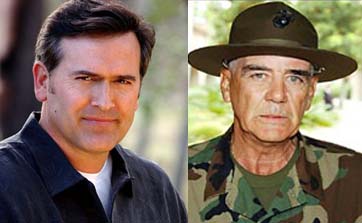 |
| Bruce Campbell (left) and R. Lee Ermey |
A: If they portray me as a younger man, then it would have to be Bruce Campbell. Believe it or not, there was a lot of joking and good-natured ribbing among FVZA agents, and I think Campbell could capture that side of the job effectively.
If the movie were to be set in the present, then I would have to go with R. Lee Ermey. I might not be as tightly wound as Ermey, a former U.S. Marine Corps drill instructor, but I still carry with me the discipline that I learned at the Academy; I expect a lot from myself and those around me.
A: Like John, a number of people have asked me about The Zombie Survival Guide, so it's high time I offered a review.
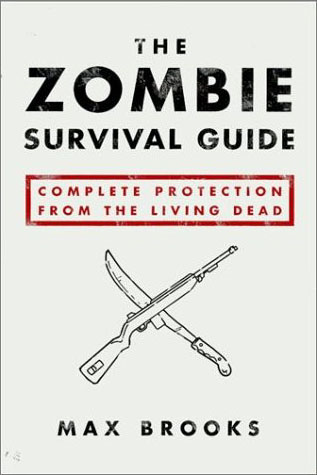 |
| The Zombie Survival Guide |
My advice when reading the book is this: take it with a grain of salt. While some of the advice offered is useful, I wouldn't rely on it in the wake of a real zombie outbreak.
First of all, there is no Solanum virus. Doesn't exist. Human Zombie Virus causes zombieism, and the virus is typically carried by rats. Second, zombies are not dead, as claimed in the book (and, to be fair, in countless zombie movies). Zombies are very much alive. Cellular respiration continues, they move, their pupils react to light. While undead is a useful phrase, it is not an accurate one. I repeat: zombies are alive, and if you don't know it now, you will when one locks down on your arm.
With respect to the book's tips on fighting zombies, it is not true that you need only one bullet to bring down a zombie. I have personally seen zombies take several shots to the head and keep coming. Essentially, you need to remove a zombie's head from its body to stop it. Whether you do that with a shotgun blast or a sword is your choice.
On other caveat: the apocalyptic Class 4 zombie outbreak described in the book could never happen, because zombie mobility, not too great to begin with, goes downhill quickly over time.
The rest of the book includes information in surviving zombie outbreaks, along with recorded attacks (including a couple that are remarkably similar to ones posted on this site back in 2001.)
Read The Zombie Survival Guide for the entertainment value, but don't treat it as the gospel truth.
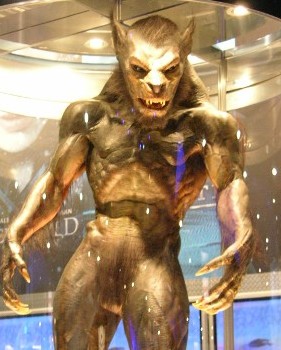 |
| Werewolf from Underworld: Evolution on display at a comic book convention |
Much of Underworld and its sequel Underworld: Evolution utilized practical special effects, including animatronic creature suits, green screen and model shots. CGI was not used as extensively as some would think. While the plot can have plenty of holes poked in it, the craftsmanship of the filmmakers, who used CG as a tool to enhance traditional special effects rather then replace them, deserves to be praised.
![]()
![]() James S. Cole, Pittsburgh, Penn.
James S. Cole, Pittsburgh, Penn.
A: Point taken, James.
I certainly didn't mean to impugn the work and talent of special effects artists when I referred to Underworld in my recent survey of werewolf special effects makeup. It takes talent plus years of hard work and training to be in a position to create special effects for major motion pictures.
Having said that, I still have yet to see a truly convincing werewolf on the big screen. I'm talking about one that occupies space and moves like the real thing. Someday, I'm confident we will see that werewolf on screen.